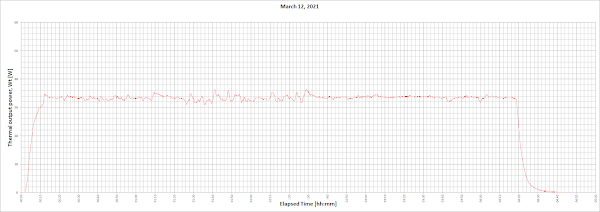Premise: "Cold nuclear fusion and LENR: one thousand nine hundred and ninety-nine ways not to do them"
Introduction: "Experiments on cold nuclear fusion and LENR"
At 00:00:50 (hh:mm:ss) the switch that allows the electrical power to reach the setup was activated and the power supply started. At 04:17:30 the same switch was deactivated and the power supply was interrupted. The supply voltage was kept constant for the entire duration of the test while the current is free to change (driving in voltage limitation). The graphs show that the current and consequently the electrical power increase in the first two minutes and then remain constant at the maximum value.
The following graph shows the trend of the temperature difference (DT) and of the water temperature entering the exchanger (Tin).
Before starting to supply electrical power, DT is zero or equal to the sensitivity of the measuring instrument (±0.1°C). Compared to the activation of the switch that starts the delivery of electrical power, the DT begins to increase with a certain delay due to the thermal inertia of the heat exchanger. The DT value stabilizes within a few minutes and its variations subsequent to the initial growth are believed to be attributed to mixing of the water inside the heat exchanger. At the end of the electrical power supply, the same delay in the response of the DT is observed, always induced by the thermal inertia of the heat exchanger.
The measurement of the flow rate of water was carried out at the beginning and at the end of the test and the two measurements were the same. For this reason it was chosen to consider the flow constant for the duration of the experiment as shown in the graph below.
By adopting the constant flow value for the entire period, the trend of the generated thermal power (Wt) and also the trend of the instantaneous COP as the ratio between the thermal power output and the electrical power input (COP=Wt/We) are calculated. Since it is not possible to calculate the COP value when the electrical power input is zero, in the absence of electrical power it has been chosen to reset the COP value.
Integrating the thermal power output and the electrical power input over time, exchanged energies are determined and the following graph was obtained from their ratio.
Introduction: "Experiments on cold nuclear fusion and LENR"
NOTES ON THE EXPERIMENT
The reported experiment is the first in a series of tests that aim to characterize the response of the reaction chamber to the varying conditions adopted. The changes introduced during the series of tests will be highlighted in the "NOTES ON THE EXPERIMENT" section using the previous test as a reference.STIMULATION TYPE
OmissisTESTED MATERIAL
OmissisRESULTS
The first three graphs (click on the image to enlarge it) show the voltage, current and electrical power values measured by the DC power supply.At 00:00:50 (hh:mm:ss) the switch that allows the electrical power to reach the setup was activated and the power supply started. At 04:17:30 the same switch was deactivated and the power supply was interrupted. The supply voltage was kept constant for the entire duration of the test while the current is free to change (driving in voltage limitation). The graphs show that the current and consequently the electrical power increase in the first two minutes and then remain constant at the maximum value.
The following graph shows the trend of the temperature difference (DT) and of the water temperature entering the exchanger (Tin).
Before starting to supply electrical power, DT is zero or equal to the sensitivity of the measuring instrument (±0.1°C). Compared to the activation of the switch that starts the delivery of electrical power, the DT begins to increase with a certain delay due to the thermal inertia of the heat exchanger. The DT value stabilizes within a few minutes and its variations subsequent to the initial growth are believed to be attributed to mixing of the water inside the heat exchanger. At the end of the electrical power supply, the same delay in the response of the DT is observed, always induced by the thermal inertia of the heat exchanger.
The measurement of the flow rate of water was carried out at the beginning and at the end of the test and the two measurements were the same. For this reason it was chosen to consider the flow constant for the duration of the experiment as shown in the graph below.
By adopting the constant flow value for the entire period, the trend of the generated thermal power (Wt) and also the trend of the instantaneous COP as the ratio between the thermal power output and the electrical power input (COP=Wt/We) are calculated. Since it is not possible to calculate the COP value when the electrical power input is zero, in the absence of electrical power it has been chosen to reset the COP value.
Integrating the thermal power output and the electrical power input over time, exchanged energies are determined and the following graph was obtained from their ratio.













Nessun commento:
Posta un commento
Puoi scrivere qui eventuali richieste di chiarimenti, perplessità o il tuo parere su quanto esposto / Please, write here questions, doubts or your opinion on the post